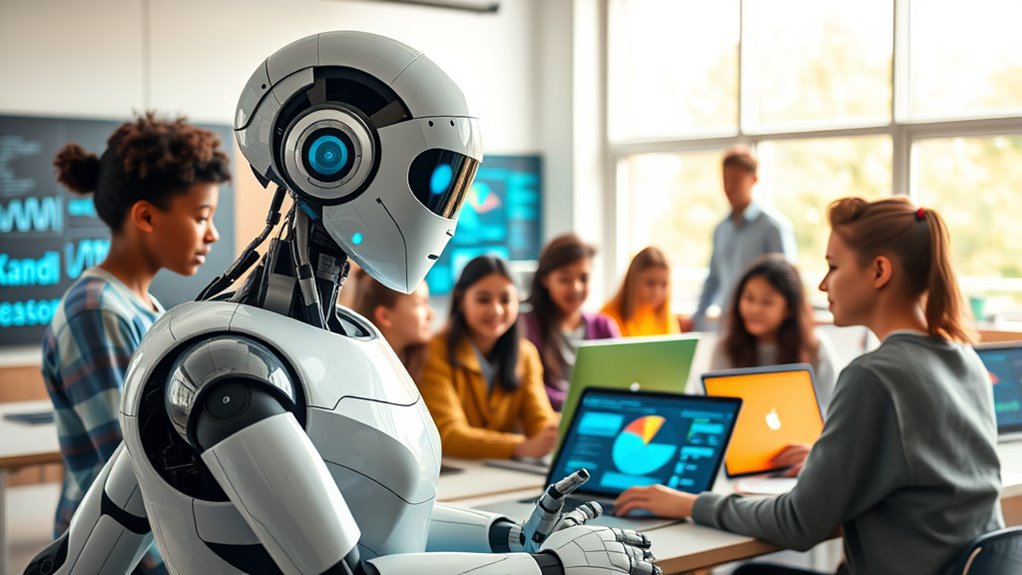AI definitely risks increasing inequality by replacing low-skilled jobs and boosting wages for high-skilled workers, which widens income gaps. It can also limit socioeconomic mobility, making it harder for workers to climb the income ladder. But some argue AI has the potential to create new opportunities if policies encourage fair distribution and reskilling efforts. To understand the real impact—what’s myth and what’s fact—you’ll want to explore how AI truly shapes our economy and society.
Key Takeaways
- AI tends to increase income inequality by benefiting high-skilled workers and capital owners more than low-skilled workers.
- Automation often replaces low-skilled jobs, disproportionately impacting less-educated workers and worsening socioeconomic mobility.
- Wage gaps are widening as AI boosts wages for skilled roles while compressing pay across different skill levels.
- Policy interventions are essential to prevent AI from deepening existing economic disparities and promoting inclusive growth.
- Empirical evidence shows AI’s role in perpetuating inequality, challenging the myth that it automatically reduces societal gaps.
The Reality of Job Displacement in the Age of AI

As AI technology advances, job displacement has become a tangible reality across many industries. You may notice that around 40% of employers plan to cut jobs where AI can automate tasks, directly affecting the workforce. By 2030, an estimated 92 million roles could disappear, though 78 million new jobs might emerge. In the US, 30% of companies have already replaced workers with AI tools, and this number could grow to 38%. During the first half of 2025, nearly 80,000 tech jobs were lost due to AI, and since 2000, automation has cost over 1.7 million manufacturing jobs. AI is transforming job landscapes, often replacing roles at a pace that challenges workers’ job security and opportunities. AI’s impact on employment continues to be a major concern, as it can both displace existing roles and create new avenues for employment. Recognizing the automation trends that influence these changes can help stakeholders better prepare for the future.
How AI Is Reshaping Wages and Income Distribution

AI is substantially increasing wage premiums for skilled workers, creating a growing income gap between those with AI expertise and others. As industries adopt AI faster, wages for exposed roles rise twice as quickly, widening economic disparities. This shift raises important questions about how AI-driven income changes will impact overall income distribution and inequality. The demand for AI skills is accelerating rapidly, further amplifying wage disparities across sectors, especially when combined with industry-specific automation advancements.
Wage Compression Trends
AI-driven automation and technological advancements are actively transforming wage structures across industries. You may notice wages are compressing, especially as AI levels the productivity playing field. Workers with different skill levels now often earn closer pay, as AI tools boost output for many. This compression affects blue-collar jobs, with some experiencing up to 70% wage reductions, and mid-tier white-collar roles, like programming and writing, feeling new pressure. Around 14% of workers have already faced AI-related displacement, shaping early wage shifts. You’ll also see AI reducing premium pay for specialized skills, standardizing productivity. Additionally, the influence of Best Beaches and popular coastal destinations exemplifies how regional economies are adapting to new technological landscapes.
Income Gap Expansion
The adoption of artificial intelligence is reshaping the landscape of wages and income distribution by increasing economic disparities. As AI reduces the labor share of income by about 5%, wealth shifts toward capital owners and data assets, not workers. While AI boosts productivity for high-income knowledge workers—those earning around $90,000 or more—it leaves lower-skilled jobs, like manual labor and service roles, with limited gains. This intensifies wage polarization, as top earners benefit most from AI advancements. Additionally, AI-driven efficiency gains mostly favor firms that automate high-wage tasks, increasing returns to capital and widening wealth gaps. Globally, nations with better AI infrastructure and governance accelerate growth, deepening income gaps between rich and poor countries. Recent studies also show that a significant portion of AI’s economic benefits are concentrated among a small group of tech firms and investors, further exacerbating income inequality within and across nations. Overall, AI’s adoption risks amplifying income inequality within and across nations, especially when considering income distribution and access disparities.
Skill Premium Shifts
As automation technologies become more widespread, they are dramatically reshaping wage structures by altering the demand for different skill levels. AI reduces the wage gap by substituting for high-skill tasks, while robots mainly replace low-skill tasks, changing relative wages. Increasing AI capital lowers the skill premium ratio notably, pushing it down from typical levels to around 1.52 as AI and robot investments grow. This tends to exert downward pressure on high-skill wages, potentially narrowing income inequality. When AI and robots combine, the skill premium stays lower than with robots alone, further mitigating wage disparities. Market structures and policy implications play a crucial role in shaping how these technological shifts impact income distribution across different sectors. Moreover, the integration of AI into various industries accelerates the demand for AI-specific skills, which can temporarily increase wages for certain specialized roles even as the overall skill premium declines.
The Impact of Automation on Socioeconomic Mobility

Automation substantially influences socioeconomic mobility by reshaping labor markets and job opportunities. As automation replaces low-skilled jobs, you may face higher unemployment or wage reductions, especially if you lack advanced skills. Regional differences matter—areas with heavy robot adoption experience more significant disruptions, making it harder for workers to shift. For your children, growing up in industries with high automation exposure can limit upward mobility, perpetuating income disparities across generations. Automation also worsens income gaps by reducing real wages for less-educated workers, especially men. Long-term unemployment becomes a concern, and opportunities to transfer into new sectors diminish for those in low-wage roles. Research shows that children with parents highly exposed to robots at occupational and industry-region levels are less likely to reach the top income quartile, highlighting the intergenerational effects of automation. Moreover, the labor market dynamics influenced by automation often favor highly skilled workers, further entrenching income inequality.
AI’s Role in Widening or Narrowing Economic Gaps

Does AI’s rapid adoption widen or narrow economic gaps? It mostly widens them, benefiting high-income workers and capital owners more than others. You’ll notice that:
- Higher-income knowledge workers see significant productivity boosts from AI, especially those earning around $90,000 or more.
- Wealthy individuals and firms capture most AI-driven capital gains, increasing wealth concentration.
- Lower-skilled, manual, and service workers get fewer productivity benefits, deepening income polarization.
- Empirical evidence suggests that AI’s benefits are concentrated among those already at the top of the income and wealth distributions, further entrenching inequality.
- The rise of AI-driven automation often results in job displacement for lower-income workers, accentuating existing economic disparities.
While some low-wage roles, like customer service, see some gains, they’re rare. AI tends to favor those already well-educated and with access to capital, making economic disparities more pronounced unless policies intervene. Without action, AI risks fueling existing inequality even further.
Educational Challenges and Reskilling Needs

The rapid adoption of AI in education presents significant challenges for both schools and educators. Despite a 74% increase in AI training through 2025, over half of teachers (51%) still feel unsupported and unprepared to use AI effectively. Nearly half (49%) lack clarity about AI’s potential and applications, fueling uncertainty. Budget constraints and technical issues also hinder implementation, with 34% reporting integration difficulties. Cybersecurity risks have risen sharply, and only about half of schools have robust plans in place. Additionally, many educators worry about data security and ethical concerns like bias and privacy. To succeed, teachers need ongoing professional development focused on AI skills and ethics. According to recent surveys, 68% of schools are actively seeking ways to improve AI literacy among staff. Without proper training and support, the promise of AI-enhanced education remains difficult to realize equitably.
Policy and Society: Addressing the Equity Concerns

As governments worldwide recognize the growing importance of AI, they are increasingly implementing policies and regulations to address its societal impacts. You’ll notice efforts to balance innovation with fairness, such as:
- Raising AI-related legislation by 21.3% across 75 countries since 2023, showing rising attention.
- Doubling U.S. federal AI regulations in 2024, reflecting stricter oversight.
- Investing billions in AI development, like Canada’s $2.4 billion and China’s $47.5 billion semiconductor fund.
- Approximately 50% of Americans believe AI will increase income inequality and societal polarization, highlighting public concern about the uneven distribution of AI’s benefits and risks. Understanding how data analysis influences these policies is crucial for shaping equitable AI frameworks.
These policies aim to bridge digital divides, ensure digital literacy, and prevent AI from deepening inequality. They face challenges in creating inclusive frameworks that benefit all, especially vulnerable populations. Your role involves supporting policies that promote equitable access, digital infrastructure, and responsible AI use.

As you explore the future of AI, you’ll need to balance the opportunities it offers with the risks it presents. While new roles and innovations can boost productivity and economic growth, automation also threatens jobs and widens inequalities. Staying proactive in managing these changes is essential to guarantee AI benefits everyone, not just a select few.
Embracing New Opportunities
Embracing new opportunities with AI means recognizing its potential to transform industries, boost productivity, and create millions of jobs worldwide. As AI adoption accelerates, industries like healthcare, mining, and agriculture are experiencing rapid growth, opening new markets and roles. You’ll find that AI-driven skills can earn you a wage premium and make you more competitive. The global market is booming, with the US AI industry valued at nearly $74 billion and expected to grow rapidly. To thrive, you’ll need to stay adaptable, continuously update your skills, and embrace lifelong learning. Opportunities include:
- Gaining specialized AI skills that boost earning potential
- Working across diverse sectors, from media to telecom
- Contributing to economic growth and innovation worldwide
Impact of AI on industry revenue and jobs continues to grow, demonstrating the importance of staying informed and adaptable in this evolving landscape. Additionally, developing a resilient skill set will help navigate the uncertainties of technological change and ensure long-term career stability.
Managing Emerging Risks
Exploring the future of AI requires careful management of emerging risks that could threaten progress and equity. Currently, a handful of companies, mostly in the U.S. and China, control 40% of global AI R&D investments, leaving many countries, especially in the Global South, excluded from governance discussions. This concentration risks entrenching economic power and widening disparities. Job disruption affects up to 40% of global roles, potentially increasing wage and wealth gaps. Biases, data access issues, energy costs, and uneven adoption threaten to deepen existing inequalities across regions and industries. To navigate these risks, international cooperation, inclusive policies, and multi-stakeholder frameworks are essential. Addressing talent shortages, security concerns, and transparency will help prevent further marginalization and foster more equitable AI development. A global AI framework is also crucial to promote shared standards and accountability across nations.
Frequently Asked Questions
How Can Policymakers Effectively Reduce Ai-Driven Economic Inequality?
To reduce AI-driven economic inequality, you should focus on creating inclusive policies that support vulnerable workers through retraining and upskilling programs. Promote digital access and infrastructure to make certain broader participation. Encourage responsible AI adoption by firms and develop global governance frameworks that promote transparency and fair distribution. Strengthen social safety nets and implement progressive taxation to address disparities. By taking these steps, you can foster a fairer, more equitable AI-driven economy.
What Industries Are Most Vulnerable to Ai-Related Job Losses?
You’re probably wondering which industries face the biggest AI threat, right? Ironically, it’s those you’d least expect—tech, manufacturing, retail, and admin jobs. AI’s replacing mid-level tech roles, automating routine manufacturing, and even cutting retail cashier jobs. You might think these industries are thriving, but AI’s quietly eroding traditional jobs, leaving workers scrambling. So, surprise! The sectors we rely on most are the most vulnerable to AI’s relentless march.
How Will AI Impact Global Income Disparities?
You might think AI will only widen income gaps, but it could also help reduce disparities if widely accessible. If lower-skilled workers get AI tools to boost productivity, they can improve their earnings. However, if AI mainly benefits capital owners and high-income earners, wealth could concentrate further. Your challenge is ensuring equitable access and policies that support retraining, so AI’s benefits reach everyone, not just the privileged few.
What Role Does Education Play in Mitigating Ai’s Inequality Effects?
You play a vital role in mitigating AI’s inequality effects through education. By advocating for equitable access to AI resources, supporting teacher training, and promoting ethical AI use, you help guarantee all students benefit equally. You can push for policies that address infrastructure gaps, implement culturally responsive AI tools, and foster inclusive learning environments. Your efforts help prevent AI from deepening existing disparities and promote fair educational opportunities for everyone.
Can AI Create More Equitable Job Opportunities Worldwide?
You might think AI automatically levels the playing field, right? Well, surprisingly, it can actually create more equitable job opportunities worldwide—if you’re in the right industry or region. AI’s growth offers new, high-paying roles, but access depends on education and skills. So, while AI promises fairness, without targeted efforts, it risks widening the gap, leaving some behind while others ride the wave of innovation.
Conclusion
As you consider the evolving landscape of AI, ask yourself: will you harness its potential to bridge gaps or let it deepen divides? The choices society makes now will shape who benefits and who gets left behind. Embracing reskilling, equitable policies, and thoughtful innovation can turn AI into a tool for fairness. Are you ready to be part of a future where technology uplifts everyone, or will you let inequality win?









